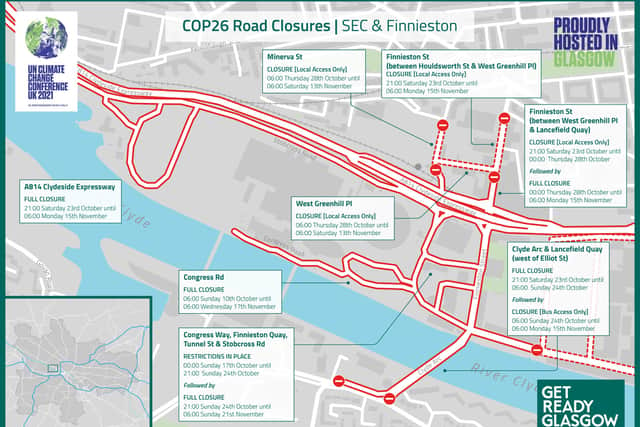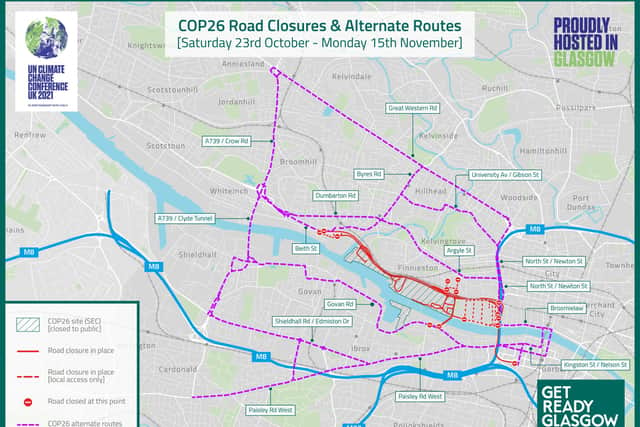COP26 travel disruption: road closures, train strikes and public transport changes during Glasgow climate summit
and live on Freeview channel 276
The COP26 climate summit is now less than a week away and Glaswegians are being warned to expect significant travel disruption as thousands of world leaders and summit delegates descend on the city.
More than 25,000 attendees, including leaders from around 120 countries, are due in the city for the summit, which is being held at the Scottish Event Campus (SEC) from 31 October until 12 November.
Advertisement
Hide AdAdvertisement
Hide AdAs a result, many roads around the venue are being closed, with diversions expected to cause congestion and delays in other parts of the city.
Which roads are closed?


Road closures will vary during the run-up to the summit and during the event itself, with some also remaining closed after the event.
Areas around the SEC summit venue will see the most impact, with key routes around the arena closed for several weeks. More than 9,000 residents in nearby Finnieston, Anderston and Yorkhill will be affected by parking restrictions and other security measures.
The Clydeside Expressway is already shut and restrictions are already affecting other routes.
Advertisement
Hide AdAdvertisement
Hide AdGet Ready Glasgow has provided a list of the closed roads as well as publishing a series of maps showing closed roads and alternative routes on its website, alongside “heat maps” of disruption.
Road closures will include:
- Congress Road: Closed from 6am on 10 October to 6am on 17 November.
- Congress Way, Finnieston Quay, Tunnel Street, Stobcross Road (section Parallel to A814) and Castlebank Street. These roads will be subject to lane restriction and road closures between 17 and 23 October. Full road closures will be in place from 9pm on 24 October to 6am on 21 November.
- Clyde Arc (the Squinty Bridge) and Lancefield Quay: Closed from 9pm on 23 October to 6am on Monday 15 November. Both will reopen to service buses only at 6am on 24 October.
- Finnieston Street – Houldsworth Street to Lancefield Quay: Closed from 9pm on 24 October to 6am on 15 November. Local Access southbound will be maintained until 28 October.
- Clydeside Expressway – Partick Interchange to Anderston (Jct 19): Closed from 9pm on 23 October to 6am on 15 November.
- Minerva Street - West Greenhill Place: Closed from 6am on 28 October to 6am on 13 November. Local access to private car parks will be maintained.
The M8 and M74 will also be affected by increased traffic due to nearby road closures and event traffic as well as the closure of some slip roads on the M8. Drivers are being warned to expect queuing and delays, particularly around the Clyde Tunnel.


How is public transport being affected?
The road closures are affecting bus services, with some services being diverted away from the summit area. First Bus, which operates the main passenger services in Glasgow has said that services 1/A/B/C/D and X4 will be affected by road closures, with stops closed and routes changed.
Rail services are also expected to be significantly disrupted during the summit.
Advertisement
Hide AdAdvertisement
Hide AdThe RMT union has said it intends to go ahead with strike between 1 and 12 November, affecting the conference and posing the threat of “chaos” according to the union’s general secretary.
Trains are expected to be busier than usual as delegates are encouraged to use rail services to access the SEC, along with regular passengers and travellers trying to avoid driving.
To counter additional demand, Scotrail has added more carriages to trains running to the SEC, and between Glasgow and Edinburgh. It has also added a number of late-night services between Glasgow and Edinburgh, Ayrshire, Dunbartonshire and Stirling.
It predicts that Saturday 30 and Sunday 31 October, and Friday 5 to Sunday 7 November will be the busiest days on the network.
Advertisement
Hide AdAdvertisement
Hide AdHow long will the disruption last?
While the summit lasts for two weeks, the disruption is expected to affect the city for several weeks before, during and after.
Some roads are already closed and some will remain shut to the public until late November. Fringe events, including protests, are expected to add to the disruption.
The greatest disruption is expected to be during the conference, with Saturday 6 November predicted to see the most upheaval. It has been designated the Global Day For Climate Justice and around 50,000 climate protesters are expected to join a march from Kelvingrove Park to Glasgow Green.
Friday 5 November will also see the Youth Climate Protest, with around 8,000 young people joining a march from Kelvingrove Park to George Square.
The disruption is also expected to be felt outhwith Glasgow, with an impact on roads and public transport routes between the city and other parts of the Central Belt.
Comment Guidelines
National World encourages reader discussion on our stories. User feedback, insights and back-and-forth exchanges add a rich layer of context to reporting. Please review our Community Guidelines before commenting.
